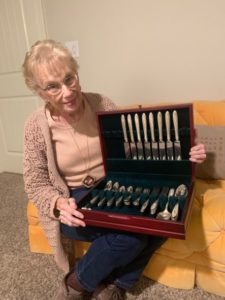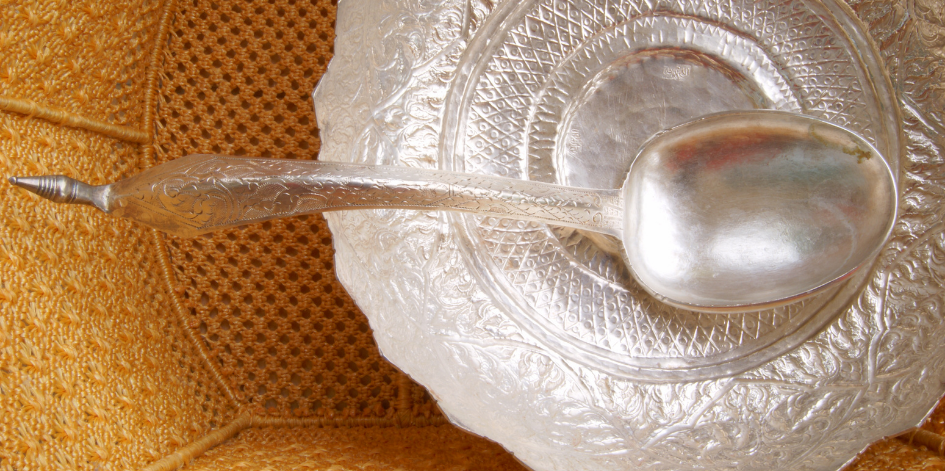It is Christmas night, and I finally attend to all the dishes and platters that accumulated after an entire day of cooking and baking. I listen to an audiobook as I handwash all of my Christmas best. Plates and platters decorated with simple evergreens are rinsed and dried, and I gently place them to the side as I turn my attention to the heap of knives and forks still soaking in the suds in front of me. I pick up the first knife and run my fingers over the delicately engraved cursive “T” decorating its handle.
A few minutes later, my hands full of clean silverware, I head to my kitchen island where the flatware chest waited. I love the detailing of this case with its plush green velvet lining and brass knobs set against a mahogany finish. However, after a couple of years of infrequent use, a thin layer of dirt and grime now cakes the sides and top of the chest, and I head to my table where I can sit and fully concentrate on cleaning the lid. As I put the case in my lap to get a better angle to scrub, I think back to when I received this gift.
I want to pass on more than just vague remembrances.
The Special Gift
Over twenty years ago, this flatware, engraved with a “T” for our last name, came as an engagement present from my mother-in-law, Lainey. A family heirloom, the silverware had been passed down five generations, and while I can remember a few aspects of the set’s origin story, I want to pass on more than just vague remembrances.
Thankfully, a week later, the opportunity to sit and chat with Lainey presented itself. We sat and talked heirlooms, engagement traditions in a small town, and bringing back a few “lost arts.”
Here is what she had to share:
PPT: Ok, well, you gave us this set at our engagement shower, and I remember it has a story behind it. First off, let’s begin with this, is this set pure silver, sterling silver, or silver-plated?
Lainey: It is silverplate. It is a service for eight, and you can usually tell the manufacturer by the back markings, but time has faded the marks. Look here, and you can tell that these don’t match exactly. Minnie Rea, the family member who gave it to me, shared that the collection had lost a few pieces throughout the years.
So for me to have a complete set, Minnie had to go out a purchase a couple of pieces that resembled the originals. A little detail that I love is that it came with serving spoons. You don’t find many sets that come with serving utensils, but this set came with seven!
PPT: So, I remember parts of this story, but please tell it to me again.
 Lainey: I don’t remember the year, but it was the mid-nineties. I was working with hospice, and I needed to attend a convention in South Alabama. My husband, at the time, George, had a cousin named Minnie Rea, who lived close to the conference. I called her to tell her that I would like to come for a visit while I was there, and she insisted that I stay with her and her husband, Johnny.
Lainey: I don’t remember the year, but it was the mid-nineties. I was working with hospice, and I needed to attend a convention in South Alabama. My husband, at the time, George, had a cousin named Minnie Rea, who lived close to the conference. I called her to tell her that I would like to come for a visit while I was there, and she insisted that I stay with her and her husband, Johnny.
Before I left for my meetings one morning, Minnie Rea pulled me to the kitchen and said, “I want you to sit right here just a minute. I’ll be right back”. I wish you could have seen her, she came in, and she walked slowly to me and set this box on the table. She opened the box and said, “I want you to have this.”
I gasped. I was so amazed and expressed that to Minnie Rea. Then I noticed the engraving. That is when Minnie Rea leaned in and said, “It was Momma and Daddy’s. I was the only one who married, and Mama wanted me and Johnny to have it as a wedding gift.
So I took it whenever we had a special occasion, and when we had company, I pulled it out, shined it, and used it. But now we are retired and have very few special events. And we love you so much and want you to have it, and thought that you could use it for all of your special occasions.
PPT: Is there a special occasion that stands out in your mind? Or a special memory attached?
Lainey: I used it for Sunday dinners constantly. We sat down and ate a Sunday dinner almost every Sunday. I would start the meal before we left for church on those mornings so that it would be almost ready by the time we returned. So, most of my memories center around Sunday dinners with all of us gathered at the table.
PPT: So, what made you think of handing it down to us?
Lainey: Well, usually, the bride picks out silver, crystal, and china. However, you both were finishing up college, and I did not know if you knew about the tradition of picking out wedding china and accessories. I just knew that I wanted you to have something fancy if you had a special occasion or meal.
PPT: Good call! That tradition escaped me. When I registered for gifts, I registered for everyday plates. Even the china I have now has been passed down from my grandmother. None of my engaged friends picked out china patterns. Let me ask you this, in your opinion, is this specific tradition more of a generational one or one linked to a particular region or part of the country?
Lainey: I believe it is a little of both. Growing up in the South, your next trip was to the local jewelry store after your engagement. Herbert’s, a jewelry store in Fort Valley, Georgia, carried the most options for china and crystal. After you made all of your choices, the store then laid out an entire table displaying your preferences so that when guests came in to buy a wedding present, they could purchase pieces from your registry. It is just what you did. Back then, when you set up a new home, you wanted to keep a nice set of dishes on hand for special occasions. It’s truly a lost art.
PPT: You said “lost art,” which makes me think of my Mimi with her love of hand-written letters. Also, I agree. My mother always laid out the fancier dishes when company came for dinner. It compels me to pull out the nice things for everyday meals. Celebrate the simple occasions, not just the special ones.
Lainey: I believe some of these traditions transferred down from our heritage. We have Irish, Scottish and English roots; many cultures hold tightly to tradition. I think of England with the proper tea time gathered around an elegantly set table. Even in the White House, the Kennedys provide a great example. Everyone noticed how they entertained. All of this played a role in shaping society and culture.
Final Takeaways
It is around lunchtime as I am putting the finishing touches on this story. I work through my final edits and glance down to see an orange index card with a few reminders that I have jotted down for myself.
I think they are good enough to pass along:
- Heirlooms make excellent gifts.
- Spend more time around the table. Make a roast or make a sandwich. It doesn’t matter. Just gather.
- Write someone a hand-written letter at least once a month. It will thrill the person on the receiving end and put your cursive skills to good use.
- Use fancy plates and flatware. Pull them down from the shelves and set them out more regularly. Even on a Wednesday at noon.

